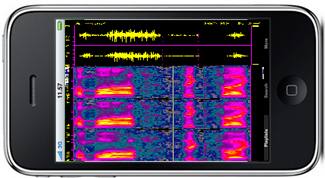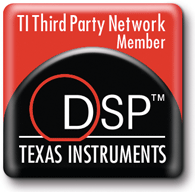
|
|
iPhone waveform display of secure voice and low bitrate voice diagnostic data
|
Secure, Low Bitrate Voice for Smartphones and Tablets
Overview
Smartphones use voice bit rates as low as 5000 bps, based on GSM and CDMA standards
1 implemented by telecom carriers such as AT&T, Verizon, Sprint, T-Mobile, and others. What if you need lower than that?
Smartphones also rely on carrier-provided encryption. What if you need greater security? For example, AES-256 or better?
In these cases, special smartphone apps are needed, for two reasons: (i) to implement the new functionality, and (ii) to move your voice data streams transparently across telecom carrier networks. The second step is key, as telecom networks contain equipment such as base stations, cell towers, backhauls, and mobile stations that expect fixed standards. To accomplish this, Signalogic smartphone apps "encapsulate" low bitrate and secure voice data in various ways so as to maintain full compatibility with existing
carrier equipment.
Applications
- Low bitrate applications such as voice-over-satellite or voice-over-HF
- Secure voice/data applications, such as corporate communications and medical
- Compatibility with other terminals, such as law enforcement or military tactical radios
Smartphones and Tablets
Most smartphones and tablets have a multicore CPU that contains:
- an ARM core (or dual core)
- a graphics, or "GPU", core
- a media processing accelerator
Examples include iPhones, various Android phones such as HTC and Samsung, and tabets such as iPad and Xoom. As the ARM core is not good at running complex, compute-intensive processing, the
media processing accelerator helps with voice and video, for example image compression needed to conduct video chat. But the media accelerator is usually a hard-wired or "fixed" type of
circuitry, specifically designed for certain media functions. This saves cost and
improves battery life, but does nothing to support low bitrate and secure voice.
 Signalogic is an authorized
Signalogic is an authorized
TI Third-Party Developer
|
Smartphones and Tablets with a Texas Instruments CPU
Some smartphones and tablets, such as Motorola Droid series, RIM Playbook, and
LG Optimus, in place of a media accelerator, use a
Texas Instruments
OMAP multicore CPU which includes a high performance, programmable DSP (digital signal processing) core. OMAPs make it straightforward to run complex,
numerical algorithms that provide low bitrate voice and/or high security. Signalogic smartphone apps perform best on OMAP-based devices.
Smartphone Low Bitrate Voice
Signalogic uses the
MELPe voice codec to provide low bitrate voice functionality to smartphone. MELPe provides bitrates of 600, 1200, and 2400 bps.
Smartphone Secure Voice
Signalogic implements AES-256 to provide secure voice on smartphones and tablets.
Carrier Compatibility
Signalogic low bitrate voice apps are compatible with carrier networks and endpoints, including other phones and
tablets, land lines, and PC softphones. In cases where two phones or tablets (or more than 2, if conferencing is active) are using a Signalogic app to communicate, no additional software is required. In cases where one endpoint is
using a Signalogic app and the other is not, a procedure known as transcoding is required. To accomplish this,
Signalogic offers the
SigIMS software, which can run either on Signalogic
servers or customer-provided servers.
Signalogic secure voice apps are also compatible with carrier networks and endpoints. Only cases where all phones or
tablets on the call are using a Signalogic app to encrypt voice are supported.
NOTES
1 Examples include G.729, GSM-AMR, EVRC, and wideband audio codecs.

 Signalogic is an authorized
Signalogic is an authorized


